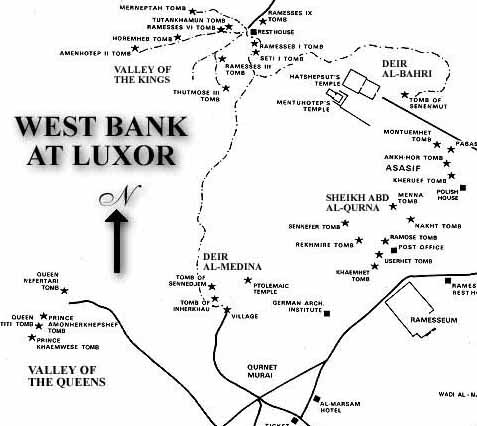
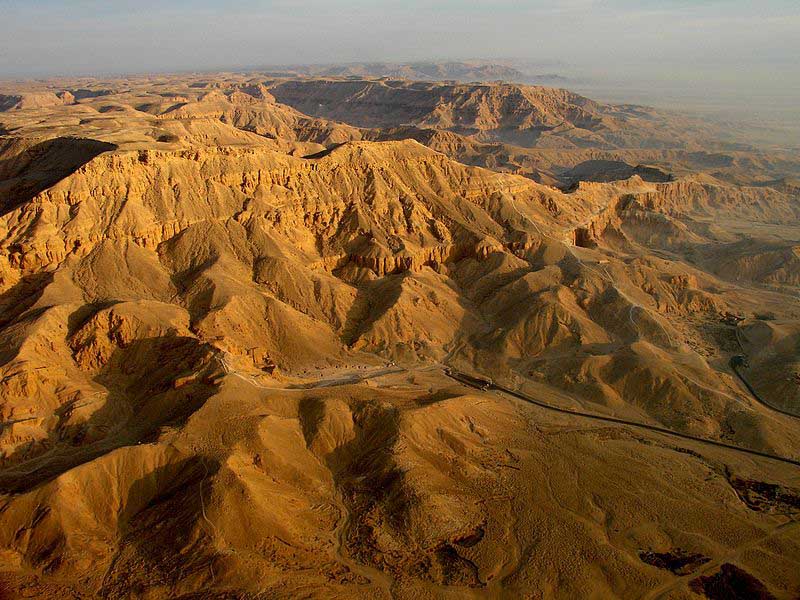


The Valley of the Queens, also known as Biban el-Harim, Biban el-Sultanat, and Wadi el-Melikat, is a place in Egypt where wives of Pharaohs were buried in ancient times. In ancient times, it was known as Ta-Set-Neferu, meaning - 'the place of the Children of the Pharaoh', because along with the Queens of the 18th, 19th and 20th dynasties (1550-1070 BCE) many princes and princesses were also buried with various members of the nobility. The tombs of these individuals were maintained by mortuary priests whom performed daily rituals and provided offerings and prayers for the deceased nobility.
The valley is located near the better known Valley of the Kings on the west bank of the Nile across from Thebes (modern Luxor) . This barren area in the western hills was chosen due to its relative isolation and proximity to the capital.
The kings of the 18th dynasty, instead of the traditional building of pyramids as burial chambers (perhaps because of their vulnerability to tomb robbers), now chose to be buried in rock-cut tombs.
This necropolis is said to hold more than seventy tombs, many of which are stylish and lavishly decorated. An example of this is the resting place carved out of the rock for Queen Nefertari (1290-1224 BCE) of the 19th Dynasty. The polychrome reliefs in her tomb are still in tact.
The ancient Egyptians gave it the name Set Neferu, meaning "seat of beauty". From 1903-1906 an Italian expedition discovered about eighty tombs, some of which belonged to children of royalty. Many were severely damaged having been burned and or reduced to being used as stables for donkeys and camels. One of the most well-known tombs is that of Nefertari, the best-loved of Ramesses II's numerous wives. In her honor he built a beautiful temple at Abu Simbel.
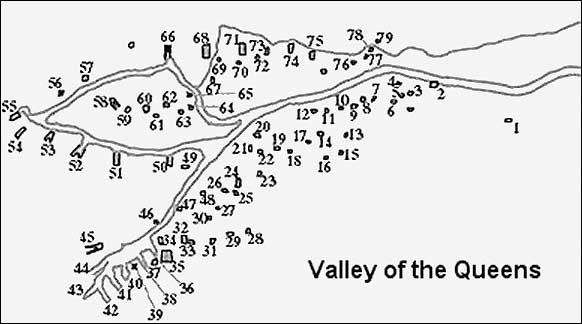
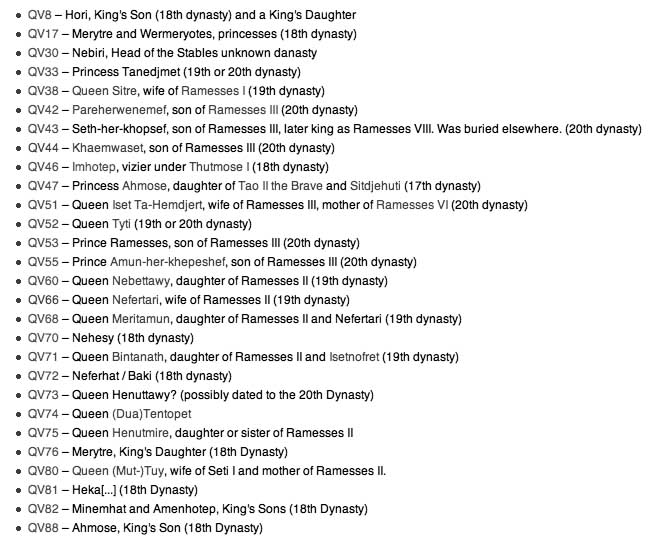
The Tomb of Khaemwese (Tomb 44): Scenes in Khaemwese's tomb show him being presented to the guardians of the gates to the afterlife along with his father. He is making an offering in the scene, and is dressed in a robe, wearing a necklace and the sidelocks of youth.
The Tomb of Queen Tyti (Tomb 52): She is probably the queen of a 20th Dynasty. She is depicted with the sidelocks common to the Egyptian young of the period and in the presence of the gods Thoth, Atum, Isis and Nephthys. In the next chamber the queen is shown making offerings to Hator the cow, and in the last chamber the gods Neith, Osiris, Selquit, Nephthys and Thoth.
The Tomb of Amenhikhopeshef (Tomb 55): Amenhikhopeshef was a son of Ramses III and scenses show him with his father and the gods Thoth, Ptah and others. He was probably about nine years old when he died. Scenes show him being presented to various gods, including Anubis, the Jackal-headed god of the dead, by his father, Ramses III. A premature baby was also found in to tomb. This belonged to this mother, who aborted upon learning of Amenhikhopeshef's death.
Fragments of burial equipments were found for several additional members of the royal families. No known tombs exist for these individuals but the existence of the burial equipment suggests that these people may have once been buried in the Valley of the Queens as well.
King's Wife Henut. Mid 18th Dynasty. Her name was enclosed in a cartouche on canopic fragments.
Prince Menkheperre, Son of Tuthmosis III and Merytre Hatshepsut. Canopic fragments were found.
King's Great Wife Nebetnehat. Mid 18th Dynasty. Her name was enclosed in a cartouche on canopic fragments.
King's Daughter Ti. Mid 18th Dynasty. Canopic fragments were found.
Queen Mut. . . perhaps Tuy (Mut-tuy), wife of Seti I, mother of Ramesses II. West of Tomb 66.
'Ahmosi King's son, son of Nebsu and Ian A hundred metres east of Tomb 47 in a small valley. Dynasty XVII
Princess Neferhet King's daughter, New Kingdom. Probably south-east of Tomb 75
Remains of canopic-jars, including one with text of a queen, Dyn XXV or XXVI (from excavation in 1895).
Tomb of Princess - from time of Amenhotep III. Position unknown.
Pets fragments were also found.
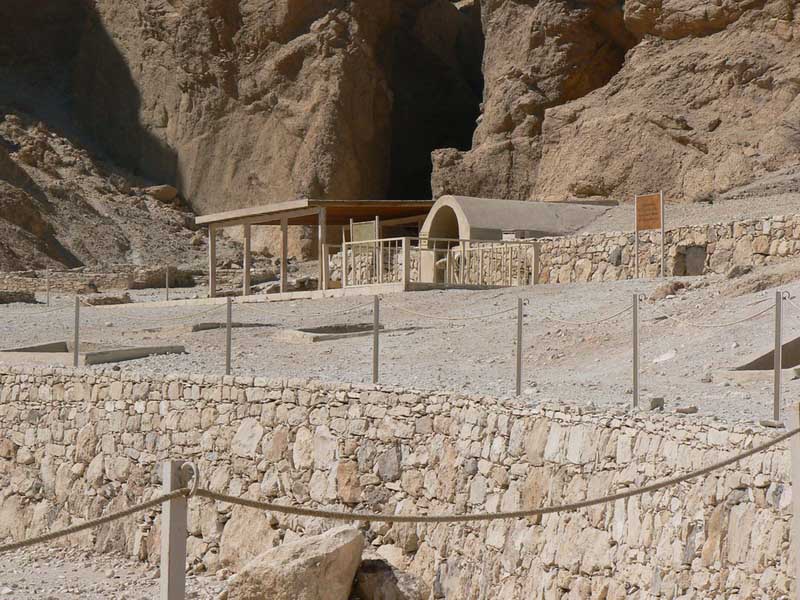
Nefertari also known as Nefertari Merytmut was one of the Great Royal Wives (or principal wives) of Ramesses the Great. Nefertari means 'Beautiful Companion' and Meritmut means 'Beloved of the Goddess Mut'. She is one of the best known Egyptian queens, next to Cleopatra, Nefertiti and Hatshepsut. Her lavishly decorated tomb, QV66, is the largest and most spectacular in the Valley of the Queens. Ramesses also constructed a temple for her at Abu Simbel next to his colossal monument here.
Although Nefertari's origins are unknown, the discovery from her tomb of a knob inscribed with the cartouche of Pharaoh Ay has led people to speculate she was related to him. The time between the reign of Ay and Ramesses II means that Nefertari could not be a daughter of Ay and if any relation exists at all, she would be a great-granddaughter.
It is possible that Nefertari is either the daughter or granddaughter of Mutnodjemet, sister of Queen Nefertiti.There is no conclusive evidence linking Nefertari to the royal family of the 18th dynasty however. Nefertari married Ramesses II before he ascended the throne.
Nefertari had at least four sons and two daughters. Amun-her-khepeshef, the eldest was Crown Prince and Commander of the Troops, and Pareherwenemef would later serve in Ramesses II's army. Prince Meryatum was elevated to the position of High Priest of Re in Heliopolis. Inscriptions mention he was a son of Nefertari. Prince Meryre is a fourth son mentioned on the facade of the small temple at Abu Simbel and is thought to be another son of Nefertari. Meritamen and Henuttawy are two royal daughters depicted on the facade of the small temple at Abu Simbel and are thought to be daughters of Nefertari.
Princesses named Bak(et)mut, Nefertari, and Nebettawy are sometimes suggested as further daughters of Nefertari based on their presence in Abu Simbel, but there is no concrete evidence for this supposed family relation.
QV66 is the tomb of Nefertari, the Great Wife of Ramesses II, in Egypt's Valley of the Queens. It was discovered by Ernesto Schiaparelli (the director of the Egyptian Museum in Turin) in 1904. It is called the Sistine Chapel of Ancient Egypt.
The most important and famous of Ramesses's consorts was discovered by Ernesto Schiaparelli in 1904. Although it had been looted in ancient times, the tomb of Nefertari is extremely important, because its magnificent wall painting decoration is regarded as one of the greatest achievements of ancient Egyptian art. A flight of steps cut out of the rock gives access to the antechamber, which is decorated with paintings based on chapter 17 of the Book of the Dead.
This astronomical ceiling represents the heavens and is painted in dark blue, with a myriad of golden five-pointed stars. The east wall of the antechamber is interrupted by a large opening flanked by representation of Osiris at left and Anubis at right; this in turn leads to the side chamber, decorated with offering scenes, preceded by a vestibule in which the paintings portray Nefertari being presented to the gods who welcome her.
On the north wall of the antechamber is the stairway that goes down to the burial chamber. This latter is a vast quadrangular room covering a surface area of about 90 square metres (970 sq ft), the astronomical ceiling of which is supported by four pillars entirely covered with decoration. Originally, the queen's red granite sarcophagus lay in the middle of this chamber.
According to religious doctrines of the time, it was in this chamber, which the ancient Egyptians called the golden hall that the regeneration of the deceased took place. This decorative pictogram of the walls in the burial chamber drew inspirations from chapters 144 and 146 of the Book of the Dead: in the left half of the chamber, there are passages from chapter 144 concerning the gates and doors of the kingdom of Osiris, their guardians, and the magic formulas that had to be uttered by the deceased in order to go past the doors.
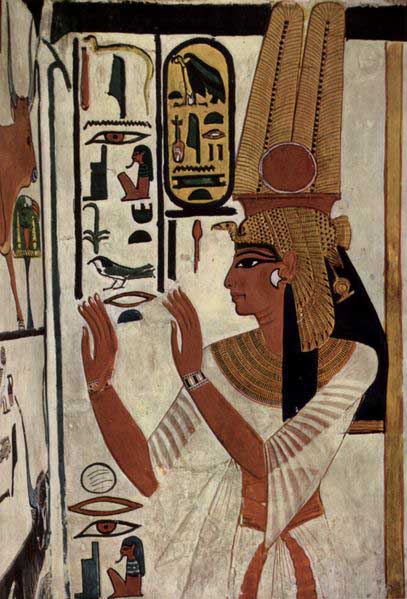
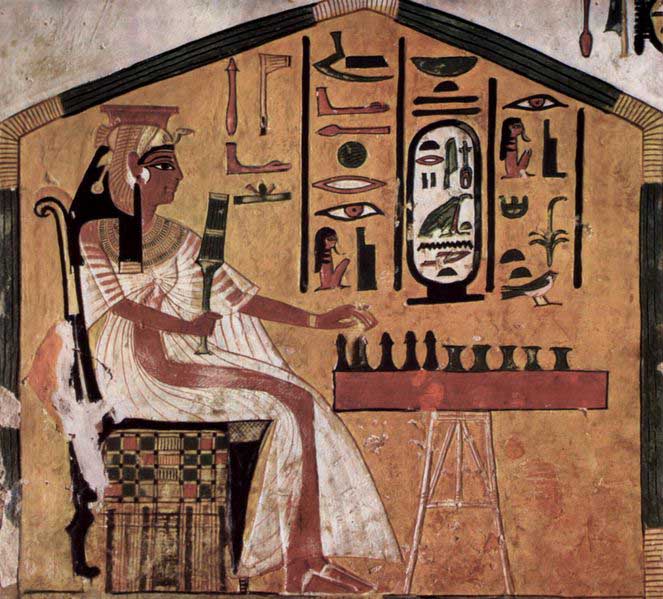
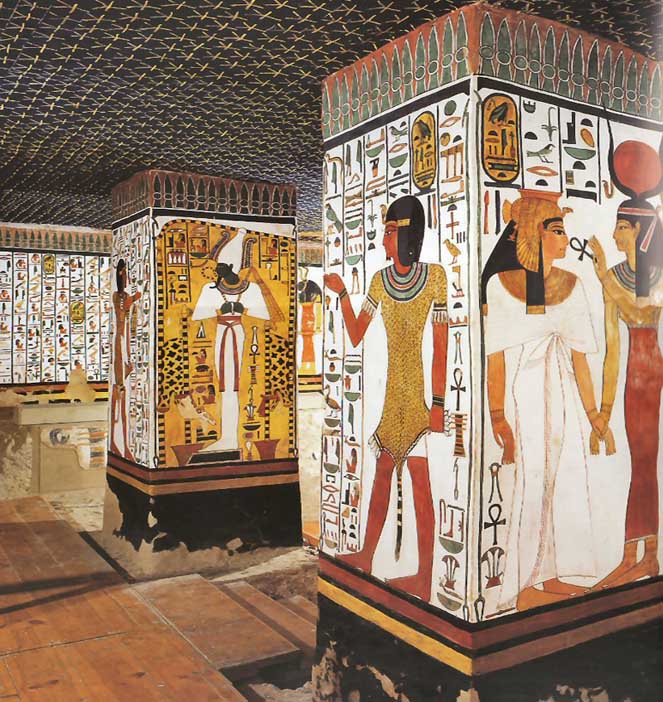
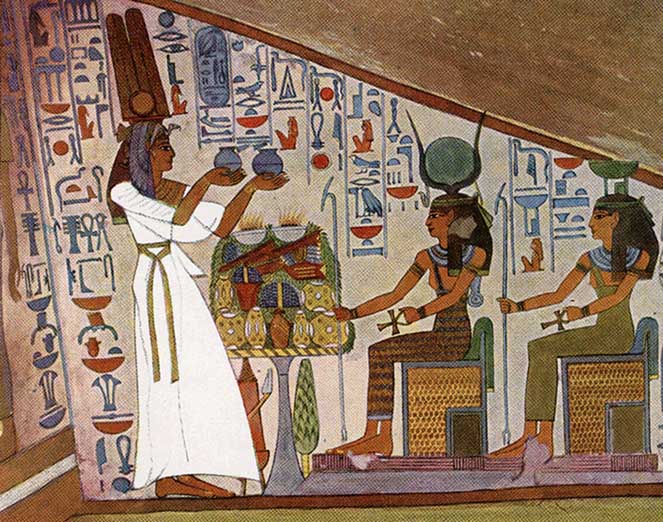
A flight of steps cut out of the rock gives access to the antechamber, which is decorated with paintings based on Chapter 17 of the Book of the Dead. This astronomical ceiling represents the heavens and is painted in dark blue, with a myriad of golden five-pointed stars.
The east wall of the antechamber is interrupted by a large opening flanked by representation of Osiris at left and Anubis at right; this in turn leads to the side chamber, decorated with offering scenes, preceded by a vestibule in which the paintings portray Nefertari being presented to the gods who welcome her.
On the north wall of the antechamber is the stairway that goes down to the burial chamber. This latter is a vast quadrengular room covering a surface area about 90 square meters, the astronomical ceiling of which is supported by four pillars entirely covered with decoration. Originally, the queen's red granite sarcophagus lay in the middle of this chamber.
According to religious doctrines of the time, it was in this chamber, which the ancient Egyptians called the "golden hall" that the regeneration of the deceased took place. This decorative pictogram of the walls in the burial chamber drew inspirations from chapters 144 and 146 of the Book of the Dead: in the left half of the chamber, there are passages from chapter 144 concerning the gates and doors of the kingdom of Osiris, their guardians, and the magic formulas that had to be uttered by the deceased in order to go past the doors.
The tomb itself is primarily focused on two things, the first being the Queen's life and the second being her death.
Ramesses' obvious affection for his wife, as written on her tomb's walls, shows clearly that Egyptian queens were not simply marriages of convenience or marriages designed to accumulate greater power and alliances, but, in some cases at least, were actually based around some kind of emotional attachment.
Also poetry written by Ramesses about his dead wife is featured on some of the walls of her burial chamber.
Nefertari's origins are unknown except that is thought that she was a member of the nobility, although while she was queen her brother Amenmose held the position of Mayor of Thebes.
The real value of the paintings found within the tomb is that they are the best preserved and most detailed source of the ancient Egyptian's journey towards the afterlife. The tomb features several extracts from the Book of the Dead from chapters 148, 94, 146, 17 and 144 and tells of all the ceremonies and tests taking place from the death of Nefertari up until the end of her journey, depicted on the door of her burial chamber, in which Nefertari is reborn and emerges from the eastern horizon as a sun disc, forever immortalized in victory over the world of darkness.
The details of the ceremonies concerning the afterlife also tell us much about the duties and roles of many major and minor gods during the reign of the 19th Dynasty in the New Kingdom. Gods mentioned on the tomb walls include Isis, Osiris, Anubis, Hathor, Neith, Serket, Ma'at, Wadjet, Nekhbet, Amunet, Ra and Nephthys.
Unfortunately by the time that Schiaparelli rediscovered Nefertari's tomb it had already been found by tomb raiders, who had stolen all the treasure buried with the Queen, including her sarcophagus and mummy. Some pieces of the mummy were found in the burial chamber, and were taken to the Egyptian Museum in Turin by Schiaparelli, where they still reside today.
The tomb was closed to the public in 1950 because of various problems that threatened the spectacular paintings, which are considered to be the best preserved and most eloquent decorations of any Egyptian burial site, found on almost every available surface in the tomb, including stars painted thousands of times on the ceiling of the burial chamber on a blue background to represent the sky.
In 1986 an operation to restore all the paintings within the tomb was embarked upon by the Egyptian Antiquities Organization and the Getty Conservation Institute; however, work did not begin on the actual restoration until 1988 which was completed in April 1992. Upon completion of the restoration work, Egyptian authorities decided to severely restrict public access to the tomb in order to preserve the delicate paintings found within.